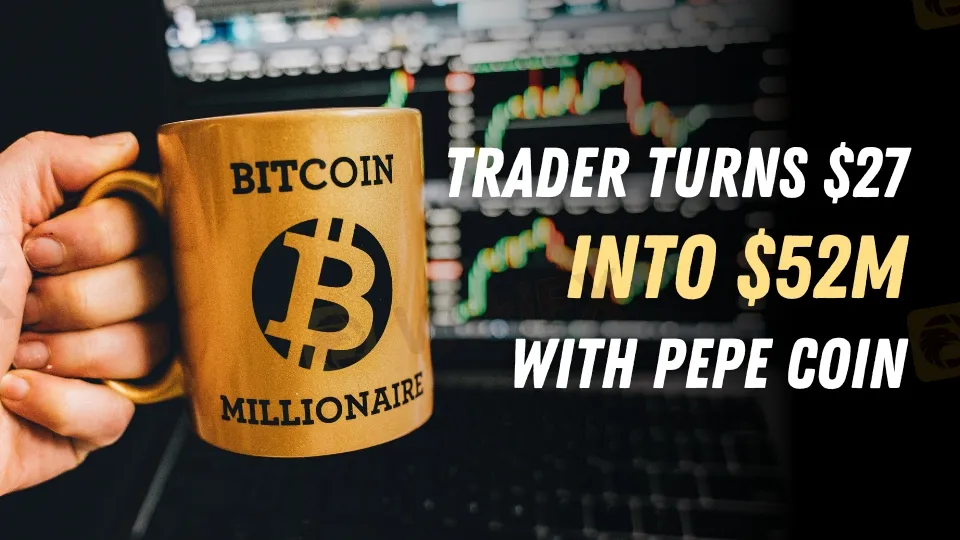简体中文
繁體中文
English
Pусский
日本語
ภาษาไทย
Tiếng Việt
Bahasa Indonesia
Español
हिन्दी
Filippiiniläinen
Français
Deutsch
Português
Türkçe
한국어
العربية
Trader Turns $27 Into $52M With PEPE Coin, Breaking Records
Abstract:A crypto trader turned $27 into $52M through PEPE memecoin, proving the massive potential—and risks—of investing in volatile cryptocurrencies.

In a jaw-dropping success story, a cryptocurrency trader turned a mere $27 investment into an astonishing $52 million profit through the popular memecoin PEPE. The feat, unveiled by blockchain analytics firm Lookonchain on December 14, highlights the unpredictable yet lucrative nature of memecoin trading.
The trader, known only as a “PEPE whale,” transferred a staggering 2.1 trillion PEPE tokens after staying inactive for an incredible 600 days. Lookonchains data shows that the trader earned an unimaginable 1,900,000x return on investment, one of the most impressive gains ever recorded in the crypto market.
PEPE Memecoin: Creating Millionaires Overnight
PEPE has become a symbol of rapid wealth accumulation. Earlier this year, another lucky investor reportedly turned $3,000 into $46 million with PEPE, achieving a jaw-dropping 15,700-fold return.
The memecoin has surged 1,600% year-to-date, making it the second-best performing cryptocurrency among the top 100 coins, according to Cryptobubbles data. Only Mantra (OM) has outperformed PEPE, skyrocketing more than 16,600%.
Is PEPE the Next Dogecoin?
Some crypto analysts believe that PEPE may follow in the footsteps of Dogecoin (DOGE), which gained global recognition as a memecoin success story. Theyve dubbed PEPE the potential “king of this cycle,” citing its viral appeal and soaring returns.

However, memecoin investments are not without their pitfalls. On December 10, the cryptocurrency market experienced a $1.7 billion liquidation, and several memecoins—including PEPE—saw sharp declines. The extreme volatility of such coins poses significant risks for traders seeking quick wins.
Mixed Reactions From the Crypto Community
Not everyone is thrilled with the memecoin craze. Binance founder Changpeng Zhao criticized the growing hype, urging developers and investors to focus on creating meaningful blockchain applications instead of speculative tokens. In a post on X (formerly Twitter), Zhao wrote that the memecoin trend has become “a little” strange compared to the lighthearted humor that originally defined it.
On the other hand, Hao Yang, head of financial products at Bybit, compared the memecoin phenomenon to punk rock—a symbol of rebellion among young investors frustrated by traditional financial systems. Despite its critics, the success of PEPE continues to capture imaginations and attract risk-tolerant traders.
PEPE: From Meme to Market Sensation
The story of PEPE began in 2005 when artist Matt Furie created the cartoon frog as part of his comic series. PEPE quickly became a viral internet meme, especially within cryptocurrency communities. Other Furie-inspired memecoins, such as Brett (BRETT), Andy (ANDY), and Landwolf (WOLF), have also found popularity.
However, PEPE has faced controversy. During the 2016 U.S. presidential election, the frog meme was co-opted by alt-right groups, much to Furie‘s dismay. He has repeatedly described PEPE as a “peaceful frog-dude” and even sued Infowars’ Alex Jones in 2019 for unauthorized use of the character in political materials.
Why Investors Should Pay Attention to Memecoins
For investors, stories like this highlight the massive earning potential of cryptocurrencies, especially memecoins like PEPE. While these tokens are often volatile and unpredictable, they can deliver life-changing returns when approached strategically. By closely monitoring market trends, and volatility, and timing their investments, traders can take calculated risks to maximize profits.
However, its essential to diversify investments and avoid risking more than one can afford to lose, as the same volatility that creates millionaires can also wipe out portfolios.
Final Thoughts
The incredible story of turning $27 into $52 million underscores the unparalleled opportunities—and dangers—of the cryptocurrency world. While PEPE and other memecoins may lack intrinsic value, they continue to attract attention for their potential to deliver extraordinary profits. Investors must tread carefully, balancing optimism with a solid strategy in an ever-changing crypto landscape.

Disclaimer:
The views in this article only represent the author's personal views, and do not constitute investment advice on this platform. This platform does not guarantee the accuracy, completeness and timeliness of the information in the article, and will not be liable for any loss caused by the use of or reliance on the information in the article.
Read more

Authorities Alert: MAS Impersonation Scam Hits Singapore
MAS scam alert: Scammers impersonate officials, causing $614K losses in Singapore since March 2025. Learn how to spot and avoid this impersonation scam.

Billboard Warns of Crypto Scams Using Its Name – Stay Alert!
Billboard warns against fake crypto scams using its brand. Learn how to spot fraud and protect yourself from fake promotions.

The Impact of Interest Rate Decisions on the Forex Market
Interest rate changes determine currency attractiveness, influencing capital flows and exchange rate trends. Understanding this mechanism helps investors navigate the forex market effectively.

Rising WhatsApp Scams Highlight Need for Stronger User Protections
UK consumers lose £2,437 on average to WhatsApp scams. Revolut demands stricter verification and AI monitoring to combat rising fraud on Meta platforms.
WikiFX Broker
Latest News
TradingView Brings Live Market Charts to Telegram Users with New Mini App
Trump tariffs: How will India navigate a world on the brink of a trade war?
Interactive Brokers Launches Forecast Contracts in Canada for Market Predictions
Authorities Alert: MAS Impersonation Scam Hits Singapore
Stocks fall again as Trump tariff jitters continue
INFINOX Partners with Acelerador Racing for Porsche Cup Brazil 2025
Regulatory Failures Lead to $150,000 Fine for Thurston Springer
April Forex Trends: EUR/USD, GBP/USD, USD/JPY, AUD/USD, USD/CAD Insights
March Oil Production Declines: How Is the Market Reacting?
Georgia Man Charged in Danbury Kidnapping and Crypto Extortion Plot
Currency Calculator







